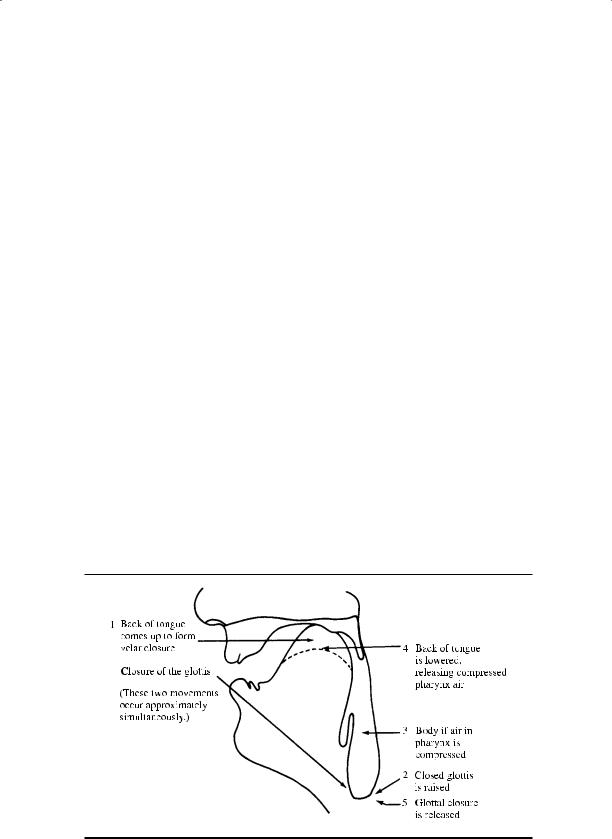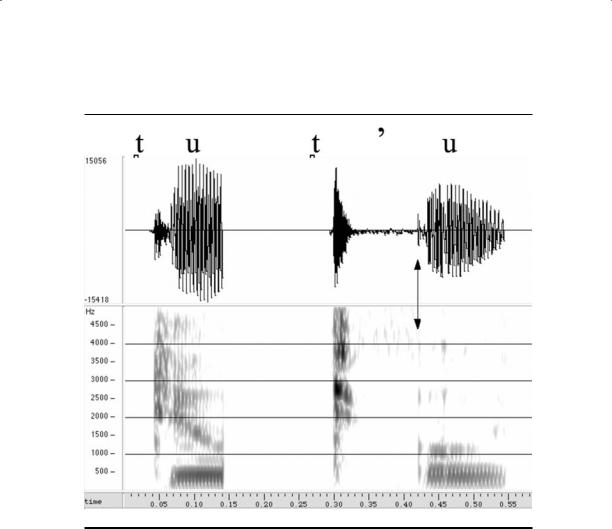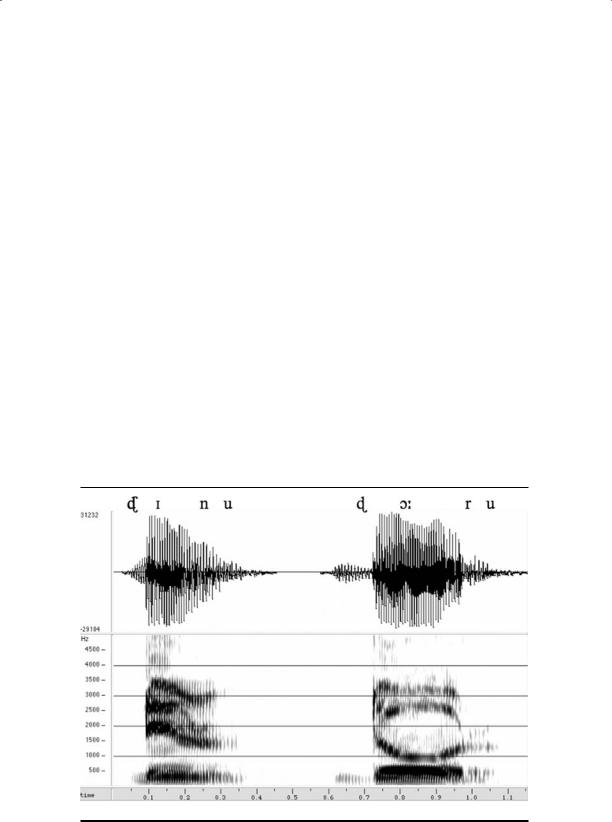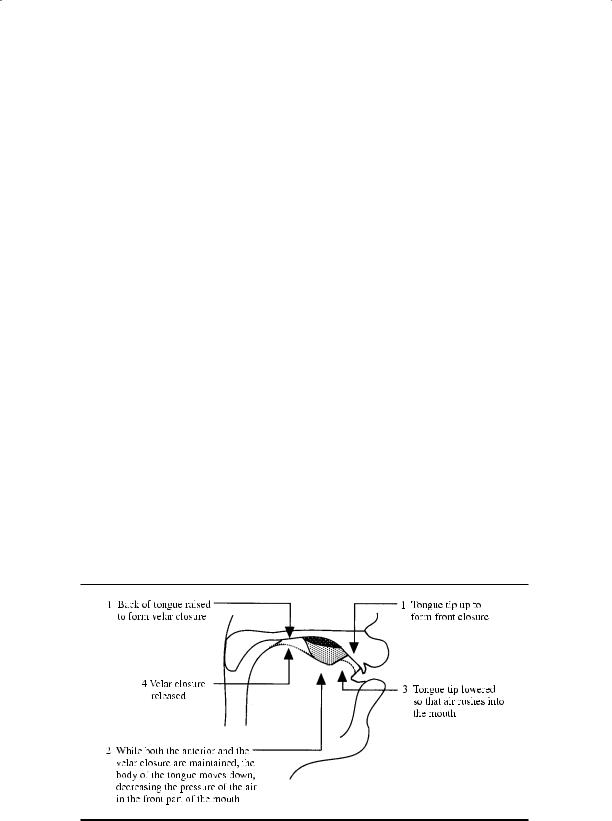
Phonetics
.pdf
PART III
GENERAL PHONETICS
Copyright 2010 Cengage Learning, Inc. All Rights Reserved. May not be copied, scanned, or duplicated, in whole or in part.

6
Airstream Mechanisms
and Phonation Types
In this part of the book, we will start considering the total range of human phonetic capabilities, not just those used in normal English speech. We will look at the sounds of the world’s languages, as in this way we can find stable, repeatable examples of almost all the different speech sounds that people can make. To do this, we will have to enlarge the sets of terms we have been using to describe English. In the first place, all English sounds are initiated by the action of lung air going outward; other languages may use additional ways of producing an airstream. Second, all English sounds can be categorized as voiced or voiceless; in some languages, additional states of the glottis are used. This chapter will survey the general phonetic categories needed to describe the airstream mechanisms and phonation types that occur in other languages. Subsequent chapters will survey other ways in which languages differ. These foreign sounds should be studied even by those who are concerned only with the phonetics of English, both because they throw light on general human phonetic capabilities and also because they are important for a precise description of the shades of sounds present in normal English utterances. In addition, many of them occur regularly in pathological forms of English.
AIRSTREAM MECHANISMS
Air coming out of the lungs is the source of power in nearly all speech sounds. When lung air is pushed out, we say that there is a pulmonic airstream mechanism. The lungs are sponge-like tissues within a cavity formed by the rib cage and the diaphragm (a dome-shaped muscle indicated by the curved line at the bottom of Figure 1.3). When the diaphragm contracts, it enlarges the lung cavity so that air flows into the lungs. The lung cavity can also be enlarged by raising the rib cage, a normal way of taking a deep breath in. Air can be pushed out of the lungs by pulling the rib cage down, or by pushing the diaphragm upward by contracting the abdominal muscles.
In the description of most sounds, we take it for granted that the pulmonic airstream mechanism is the source of power. But in the case of obstruent consonants (stops and fricatives), other airstream mechanisms may be involved. Stops
136
Copyright 2010 Cengage Learning, Inc. All Rights Reserved. May not be copied, scanned, or duplicated, in whole or in part.

Airstream Mechanisms 137
that use only an egressive, or outward-moving, pulmonic airstream are called plosives. Obstruents made with other airstream mechanisms will be specified by other terms.
In some languages, speech sounds are produced by moving different bodies of air. If you make a glottal stop, so that the air in the lungs is contained below the glottis, then the air in the vocal tract itself will form a body of air that can be moved. An upward movement of the closed glottis will move this air out of the mouth. A downward movement of the closed glottis will cause air to be sucked into the mouth. When either of these actions occurs, there is said to be a glottalic airstream mechanism.
An egressive glottalic airstream mechanism occurs in many languages. Hausa, the principal language of northern Nigeria, uses this mechanism in the formation of a velar stop that contrasts with the voiceless and voiced velar stops [ k, g ]. The movements of the vocal organs are shown in Figure 6.1. These are estimated, not drawn on the basis of x-rays.
In Hausa, the velar closure and the glottal closure are formed at about the same time. Then, when the vocal folds are tightly together, the larynx is pulled upward, about 1 cm. In this way it acts like a piston, compressing the air in the pharynx. The compressed air is released by lowering the back of the tongue while the glottal stop is maintained, producing a sound with a quality different from that in an English [ k ]. Very shortly after the release of the velar closure, the glottal stop is released and the voicing for the following vowel begins.
Stops made with a glottalic egressive airstream mechanism are called ejectives. The diacritic indicating an ejective is an apostrophe [ ' ] placed after a symbol. The Hausa sound we have just described is a velar ejective, symbolized [ k' ], as in the Hausa word for ‘increase’ [ k'a…ra ~], which, as you can hear on the
Figure 6.1 The sequence of events that occurs in a glottalic egressive velar stop [ k' ].
Copyright 2010 Cengage Learning, Inc. All Rights Reserved. May not be copied, scanned, or duplicated, in whole or in part.

138
CD 6.1
CD 6.2
CHAPTER 6 Airstream Mechanisms and Phonation Types
CD, contrasts with [ ka…ra~]… ‘put near.’ (The symbol [ … ] indicates that the vowels are long. The accents over the vowels indicate the pitch, a low tone. We will discuss tones in Chapter 10.) The CD also illustrates the contrasts between the Hausa words [ kWa…ra~]… ‘pour’ and [ kW'a…ra~]… ‘shea nut.’ It is possible to use an ejective mechanism to produce fricatives as well as stops, as Hausa does in the words [ sa…ra~]… ‘cut’ and [ s'a…ra~]… ‘arrange,’ which are also on the CD. Of course, a fricative made in this way can continue only for a short length of time, as there is a comparatively small amount of air that can be moved by raising the closed glottis.
Ejectives of different kinds occur in a wide variety of languages, including Native American languages, African languages, and languages spoken in the Caucasus. Table 6.1 gives examples of ejectives and contrasting sounds made with a pulmonic airstream mechanism in Lakhota, a Native American language. The sounds of Lakhota differ from those of English in many ways, in addition to having contrastive ejectives. Later in this book, we will discuss the unfamiliar symbols in this table.
You can probably hear the difference between the Lakhota syllables [ t 1u] and [ t 1'u ] in the audio files that accompany Table 6.1, and these differences are also apparent in the acoustic waveforms and spectrograms of the syllables shown in Figure 6.2. Both of these syllables begin with a short burst of noise—the release burst of the stop. In the case of the pulmonic egressive stop [ t1], the vowel starts about 30 milliseconds later, while in the glottalic egressive stop [ t 1'], there is a gap of over 120 milliseconds and then a second stop release burst (the second burst is marked by the double-headed arrow that points at the release burst in the waveform at the top of the figure and in the time-aligned spectrogram at the bottom of the figure). This second stop release is the release of the glottal closure. This is a clear acoustic cue telling us that the stop release burst in [ t 1'u ] was produced by a glottalic egressive airstream mechanism.
Some people make ejectives at the ends of words in English, particularly in sentence final position. You might notice this in words such as bike with a glottal stop accompanying the final [ k ]. If the velar stop is released while the glottal stop is still being held, a weak ejective may be heard. See if you can superimpose a glottal stop on a final [ k ] and produce an ejective. Now try to make a slightly
TABLE 6.1 Contrasts involving ejective stops in Lakhota. An ejective mechanism is shown by a following apostrophe.
Ejective |
p'o |
t1'uSE |
k'u |
||
|
‘foggy’ |
‘at all costs’ |
‘to give’ |
||
Voiceless Unaspirated |
paVo) t 1a |
1uwat |
kah |
||
|
‘mallard’ |
‘who’ |
‘that’ |
||
Voiceless + Velar Fricative |
x |
a |
x |
x |
ant 1a |
p |
t 1awa |
k |
|||
|
‘bitter’ |
‘own’ |
‘plum’ |
||
Copyright 2010 Cengage Learning, Inc. All Rights Reserved. May not be copied, scanned, or duplicated, in whole or in part.

Airstream Mechanisms 139
Figure 6.2 Acoustic waveforms and spectrograms of the Lakhota dental voiceless unaspirated and ejective stops.
more forceful ejective stop. By now, you should be fully able to make a glottal stop in a sequence such as [ a/a ], so the next step is to learn to raise and lower the glottis. You can recognize what it feels like to raise the glottis by singing a very low note and then moving to the position for singing the highest note that you possibly can. Doing this silently makes it easier to concentrate on feeling the muscular sensations involved. Putting your fingers on your throat above the larynx is also a help in feeling the movements. Repeat (silently) this sequence— low note, very high note—until you have thoroughly experienced the sensation of raising your glottis. Now try to make this movement with a closed glottis. There will, of course, be no sounds produced by these movements alone.
The next step is to learn to superimpose this movement on a velar stop. Say the sequence [ Ak ]. Then say this sequence again, very slowly, holding your tongue in the position for the [k] closure at the end for a second or so. Now say it again, and while maintaining the [ k ] closure, do three things: (1) make a glottal stop; (2) if you can, raise your larynx; and (3) release the [ k ] closure while maintaining the glottal stop. Don’t worry about step (2) too much. The important thing to concentrate on is having a glottal stop and a velar closure going on at the same time, and
Copyright 2010 Cengage Learning, Inc. All Rights Reserved. May not be copied, scanned, or duplicated, in whole or in part.

140 CHAPTER 6 Airstream Mechanisms and Phonation Types
then releasing the velar closure before releasing the glottal stop. The release of the velar closure will produce only a very small noise, but it will be an ejective [ k' ].
Next, try to produce a vowel after the ejective. This time start from the sequence [ AkA ]. Say this sequence slowly, with a long [ k ] closure. Then, during this closure, make a glottal stop and raise the larynx. Then release the [ k ] closure while still maintaining the glottal stop. Finally, release the glottal stop and follow it with a vowel. You should have produced something like [ Ak'/A ]. When this sequence becomes more fluent, so that there is very little pause between the release of the velar closure and the release of the glottal stop, it will be simply an ejective followed by a vowel—[ Ak'A ]. There is, of course, still a glottal stop after the release of the velar stop and before the vowel, but unless it is exceptionally long, we may consider it to be implied by the symbol for the ejective.
Another way of learning to produce an ejective is to start from the usual American (and common British) pronunciation of button as [ "bø/nÆ ]. Try starting to say button but finishing with another vowel [ ø ] instead of the nasal [ n ]. If you make sure you do include the glottal stop form of / t /, the result will probably be [ "bø/tø ]. If you say this slowly, you should be able to convert it first into [ "bø/t'/ø ], then into [ "bøt'ø ], and finally, altering the stress, into [ bø"t'ø ].
Eventually, you should be able to produce sequences such as [ p'A, t'A, k'A ] and perhaps [ tS'A, s'A ] as well. Practice producing ejectives before, after, and between a wide variety of vowels. You should also try to say the Lakhota words in Table 6.1. But if you find ejectives difficult to produce, don’t worry. Many people take years to learn to say them. Just keep on practicing.
It is also possible to use a downward movement of the larynx to suck air inward. Stops made with an ingressive glottalic airstream mechanism are called implosives. In the production of implosives, the downward-moving larynx is not usually completely closed. The air in the lungs is still being pushed out, and some of it passes between the vocal folds, keeping them in motion so that the sound is voiced. Figure 6.3 shows the movements in a voiced bilabial implosive of a kind that occurs in Sindhi (an Indo-Aryan language spoken in India and Pakistan). Implosives sometimes occur as allophones in English, particularly in emphatic articulations of bilabial stops, as in absolutely billions and billions.
In all the implosives we have measured, the articulatory closure—in this case, the lips coming together—occurs first. The downward movement of the glottis, which occurs next, is like that of a piston that would cause a reduction in the pressure of the air in the oral tract. But it is a leaky piston in that the air in the lungs continues to flow through the glottis. As a result, the pressure of the air in the oral tract is not affected very much. (In a plosive [ b ] there is, of course, an increase in the pressure of the air in the vocal tract.) When the articulatory closure is released, there is neither an explosive nor, in a literal sense, an implosive action. Instead, the peculiar quality of the sound arises from the complex changes in the shape of the vocal tract and in the vibratory pattern of the vocal folds.
Copyright 2010 Cengage Learning, Inc. All Rights Reserved. May not be copied, scanned, or duplicated, in whole or in part.

Airstream Mechanisms 141
Figure 6.3 Estimated sequence of events in a Sindhi bilabial implosive [ ∫ ].
In many languages, such as Sindhi and several African and Native American languages, implosives contrast with plosives. However, in some languages (for example, Vietnamese), implosives are simply variants (allophones) of voiced plosives and are not in contrast with those sounds. The top line of Table 6.2 illustrates implosives in Sindhi. The symbols for implosives have a small hook on the top of the regular symbol. For the moment, we will consider only the first and second rows in Table 6.2, which illustrate ingressive glottalic stops (implosives) in the first row, contrasting with regular pulmonic plosives in the second row. Sindhi has unfamiliar places of articulation illustrated
TABLE 6.2 |
Contrasts involving implosives and plosives with different phonation types |
|
||||
|
in Sindhi. |
|
|
|
|
|
|
|
|
|
|
|
|
∫ani |
|
ᶑInu |
˙atu |
ƒanu |
|
|
'field' |
|
'festival' |
'illiterate' |
'handle' |
|
|
banu |
daru |
∂o…ru |
Ôatu |
gu=u |
|
|
'forest' |
'door' |
'you run' |
'illiterate' |
'quality' |
CD 6.3 |
|
|
|
|
|
[varianto] |
|
|
|
|
|
|
|
|
|
panu |
taru |
†anu |
ca†u |
kanu |
|
|
'leaf' |
'bottom' |
'ton' |
'to destroy' |
'ear' |
|
|
pÓa=u |
tÓaru |
†Óaƒu |
cÓa†u |
kÓa=u |
|
|
'snake hood' |
(district name) |
'thug, cheat' |
'crown' |
'you lift' |
|
|
bHa…=u |
dHa«u |
∂Haƒu |
ÔHa†u |
gHa=I |
|
|
'manure' |
'trunk' |
'bull' |
'a grab' |
'excess' |
|
|
|
|
|
|
|
|
|
Copyright 2010 Cengage Learning, Inc. All Rights Reserved. May not be copied, scanned, or duplicated, in whole or in part.

142 CHAPTER 6 Airstream Mechanisms and Phonation Types
in the third and fourth columns, which we will consider in Chapter 7. The lower rows in the table illustrate phonation types that we will consider later in this chapter.
Acoustic waveforms and spectrograms of two of the words in Table 6.2 are shown in Figure 6.4. There are several differences in these displays relating to the differences between the vowels and intervocalic consonants that we will return to later in this book, but for now we would like to focus on the initial consonants [∂] and [ ᶑ ]. Both of these start with a short period of low amplitude voicing, which in the spectrogram appears as a gray bar at the bottom of the spectrogram. This is called the voice bar and is an acoustic property of all (phonetically) voiced stops. So, both [ ∂ ] and [ ᶑ ] are voiced. Interestingly, the pulmonic voiced stop [ ∂ ] has a longer voice bar than the glottalic ingressive stop [ ᶑ ]. This characteristic is present for the other Lakhota pairs in Table 6.2, but has not been reported as a phonetic characteristic of the pulmonic/implosive contrast in other languages. There is one other difference between [∂] and [ᶑ] that is consistently present for contrasts between implosives and plosives. You will notice that in the implosive [ ᶑ ], the voice bar grows louder over time, while in the pulmonic stop [ ∂ ], the amplitude of the voice bar decreases over time. This difference is almost always seen when we compare regular pulmonic stops and implosives—and might be a good cue to look for as you practice making the distinction.
Figure 6.4 Acoustic waveforms and spectrograms of the Sindhi retroflex voiced and implosive stops.
Copyright 2010 Cengage Learning, Inc. All Rights Reserved. May not be copied, scanned, or duplicated, in whole or in part.

Airstream Mechanisms 143
We do not know any foolproof way of teaching people to make implosives. Some people can learn to make them just by imitating their instructor; others can’t. (Peter Ladefoged, incidentally, was one of the latter group. He did not learn to make implosives until nearly the end of a year studying phonetics. Keith Johnson learned to make implosives by imitating his instructor’s funny pronunciation of “Alabama” and then realized that he also used the implosive [ ƒ ] in imitating the noise of liquid pouring from a bottle [ ƒE ƒE ƒE ƒE ].) The best suggestion we can make is to start from a fully voiced plosive. Say [ AbA ], making sure that the voicing continues throughout the closure. Now say this sequence slowly, making the closure last as long as you can while maintaining strong vocal fold vibrations. Release the closure (open the lips) before the voicing stops. If you put your fingers on your throat above the larynx while doing this, you will probably be able to feel the larynx moving down during the closure.
There are straightforward mechanical reasons why the larynx moves down in these circumstances. To maintain voicing throughout a [ b ], air must continue to flow through the glottis. But it cannot continue to flow for very long, because while the articulatory position of [ b ] is being held, the pressure of the air in the mouth is continually increasing as more air flows through the glottis. To keep the vocal folds vibrating, the air in the lungs must be at an appreciably higher pressure than the air in the vocal tract so that there is a pressure drop across the glottis. One of the ways of maintaining the pressure drop across the glottis is to lower the larynx and thus increase the space available in the vocal tract. Consequently, there is a natural tendency when saying a long [ b ] to lower the larynx. If you try to make a long, fully voiced [ b ] very forcibly but open the lips before the voicing stops, you may end up producing an implosive [ ∫ ]. You can check your progress in learning to produce implosives by using a straw in a drink. Hold a straw immersed in a liquid between your lips while you say [ A∫A ]. You should see the liquid move upward in the straw during the [ ∫ ].
Historically, languages seem to develop implosives from plosives that have become more and more voiced. In many languages, as we mentioned earlier, voiced implosives are simply allophones of voiced plosives. Often, as in Vietnamese, these languages have voiced plosives that have to be fully voiced to keep them distinct from two other sets of plosives that we will discuss in the next section. In languages such as Sindhi, for which we have good evidence of the earlier stages of the language, we can clearly see that the present implosives grew out of older voiced plosives in this way; the present contrasting voiced plosives are due to later influences of neighboring languages.
One other airstream mechanism is used in a few languages. This is the mechanism that is used in producing clicks, such as the interjection expressing disapproval that novelists write tut-tut or tsk-tsk. Another type of click is
Copyright 2010 Cengage Learning, Inc. All Rights Reserved. May not be copied, scanned, or duplicated, in whole or in part.

144 CHAPTER 6 Airstream Mechanisms and Phonation Types
commonly used to show approval or to signal horses to go faster. Still another click in common use is the gentle, pursed-lips type of kiss that one might drop on one’s grandmother’s cheek. Clicks occur in words (in addition to interjections or nonlinguistic gestures) in several African languages. Zulu, for example, has a number of clicks, including one that is very similar to our expression of disapproval.
The easiest click to start studying is the gentle-kiss-with-pursed-lips type. In a language that uses bilabial clicks of this sort, the gesture is not quite the same as that used by most people making a friendly kiss. The linguistic gesture does not involve puckering the lips. They are simply compressed in a more grim manner. Make a “kiss” of this type. Say this sound while holding a finger lightly along the lips. You might be able to feel that air rushes into the mouth when your lips come apart. Note that while you are making this sound, you can continue to breathe through your nose. This is because the back of the tongue is touching the velum, so that the air in the mouth used in making this sound is separated from the airstream flowing in and out of the nose.
Now say the click expressing disapproval (with the blade of the tongue touching the teeth and alveolar ridge), the one that authors sometimes write tuttut or tsk-tsk when they wish to indicate a click sound; they do not, of course, mean [ tøt tøt ] or [ tIsk tIsk ]. Say a single click of this kind and try to feel how your tongue moves. The positions of the vocal organs in the corresponding Zulu sound are shown in Figure 6.5. At the beginning of this sound, there are both
Figure 6.5 The sequence of events in a dental click. Initially, both the tip and the back of the tongue are raised, enclosing the small pocket of air indicated by the dark shading. When the center of the tongue moves down, the larger, lightly shaded cavity is formed. Then the tip moves down to the position shown by the dashed line, and, a little later, the back of the tongue comes down to the position shown by the dashed line.
Copyright 2010 Cengage Learning, Inc. All Rights Reserved. May not be copied, scanned, or duplicated, in whole or in part.
